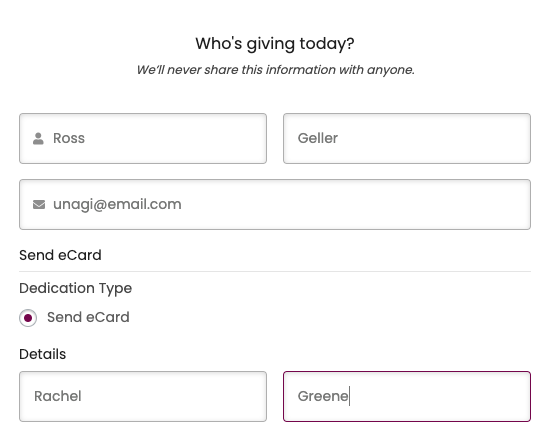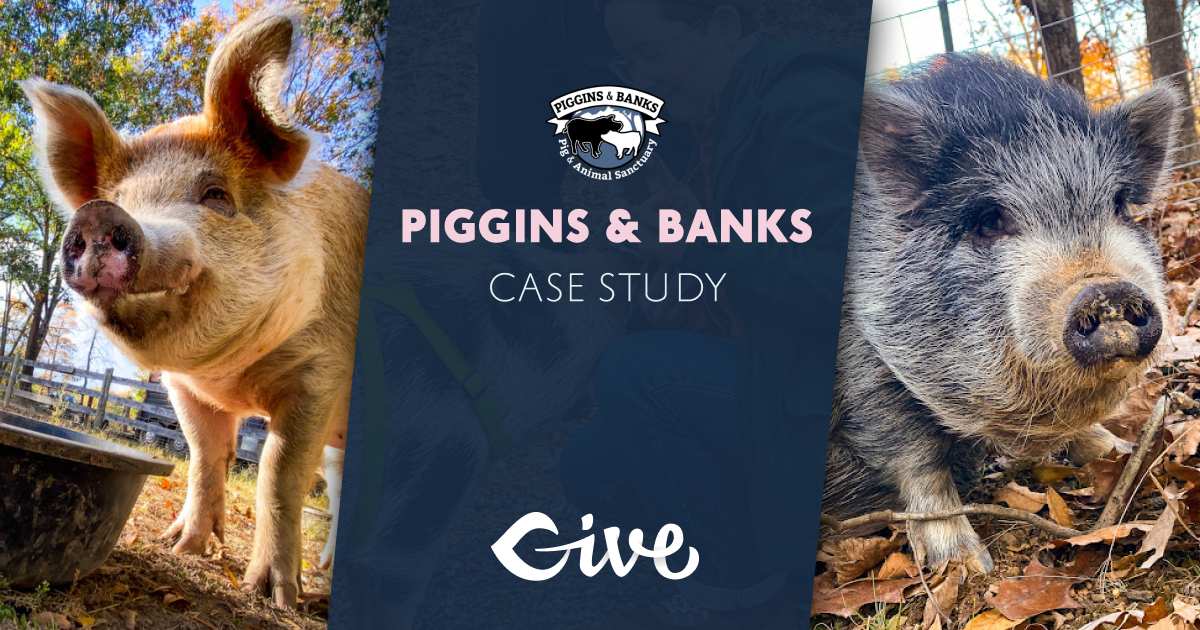Donating to a cause you care about should be an exciting and engaging experience. However, the typical donation form can sometimes feel monotonous and uninspiring. Using GiveWP’s Form Field Manager add-on, coupled with the new Visual Donation Form Builder, opens up various features that allow you to create dynamic and engaging donation forms.
Let’s explore how your organization can use conditional fields to add flair and functionality to your donation forms.
1. Gift Selection
With conditional fields, you can create a dropdown menu with different gift options based on the selected donation amount. Not only does this option motivate donors to give more, but it also adds a personal touch to their contribution.
For example, if your organization is focused on animal conservation, you could mail out a little refrigerator magnet of the animals their gift impacts.
While it’s not a traditional “thank you,” it is another layer of recognition. A study from NeonONE found that nonprofits that express gratitude and recognize their supporters experience a 40% increase in retention.
2. Photo or Art Contest
Allow your donors to submit their entries through your donation form with the upload field. This feature simplifies the submission process and encourages engagement and creativity within your network of supporters.
While this option may only be for some, it would work well for community centers, nonprofit museums, and child-minded organizations. Encourage your supporters – including volunteers and beneficiaries – to submit artwork. Include an upload field, a text field to gather information about the artist and the art, and an email address field to segment these supporters later.
Once a specific amount of time has passed, close the form to new submissions. The fun part comes next! Using Funds and Designations, you can open up voting on the submissions using funds and designations.
And lastly, set a prize. If you’re a museum, perhaps the prize is that you curate a small collection of the winning pieces and display them in the entry to your space.
3. Birthday Celebration
Celebrate your donors’ special day by collecting birthdates through the date field. You can attach this information to the donor record and use it to send personalized messages.
This is self-explanatory. Celebrating a supporter’s birthday is a great way to show you care and create a touchpoint that isn’t focused on an ask. Birthday emails sent to donors have a 300% higher open rate and a 700% higher donation rate than standard emails.
But it doesn’t have to be just birthdays – data suggests that donors who receive recognition on the anniversary of their tribute gifts contribute 50% more than those who don’t.
4. Story Submission
Encourage supporters, volunteers, and beneficiaries to share their stories by incorporating a text field. This allows the folks who feel strongly about your mission to express why they give their money and time or how your organization has helped them.
Much like Give Stories, your organization could ask folks to share their stories with you. If you provide disaster relief, have donors share the why behind their donation. Has a similar situation impacted them? Were they moved to donate because of the urgency of the crisis? Not only are you gathering important information that you can use in your storytelling, these submissions can help you further understand your audience.
5. Choose a Fund
If your organization has multiple funds or designations, use conditional fields to let donors choose where their contributions will be allocated. This empowers donors to choose exactly where they want it to go.
One such use case would be an after-school program dedicated to tutoring, feeding, and providing kids with a safe place at the end of the school day.
Allowing donors to choose where their contributions go has a positive impact on your fundraising:
- A Blackbaud study shows that nonprofits that offer designated giving options experience a 15% increase in average gift size.
- The NonProfit Times has reported that donors are 22% more likely to give when they specify where their donation will be allocated.
There are a myriad of reasons a donor might be more willing to donate when they have the funds and designation options. Perhaps they have a deeper personal connection to one of the initiatives, or they appreciate the transparency that designating their gift gives them. Or, it is that they feel ownership over their choice and can directly contribute to a particular aspect of the organization.
6. Dedicate Donations
Enable donors to dedicate their donations to loved ones, friends, or cherished memories. The Tribute feature lets donors express their sentiments and connect their gift to a special occasion or person.

Giving in honor of someone is a common yet powerful motivator. 60% of donors have a personal connection to the cause they support, with 33% of donations being made in honor of someone else. When people are given the chance to showcase their connection, they are more likely to engage and give.
7. Vote For Our Next Project
Engage your community with a voting mechanism. With a conditional dropdown, donors can participate in choosing the focus of your organization’s next campaign or project.
If your organization is one with many programs or initiatives, allowing your supporters to vote increases engagement drastically. This allows donors to feel heard in support of your mission. For instance, if you’re a community development organization, you could allow supporters to vote with their dollars on your next venture. Is it a community garden? Update to a local playground? Installing little fridges in a particular neighborhood?
All the options move the needle for your organization yet allow your donors to have a bigger hand in the outcome.
8. Recognizing Corporate Contributions
Corporations continue to give more and more each year. In 2022, companies gave more than $21B, an increase of 3.4% over 2021. Corporations make charitable gifts for a variety of reasons, including:
- Corporate social responsibility
- Employee morale and engagement
- Community relations
- Addressing societal issues
It’s important to note that the motivations for charitable giving are often strategic, and companies may engage as part of their social impact strategy. To that end, it can be important to ensure that companies who make charitable gifts to your organization receive recognition.
For corporate sponsors, the URL and company field allows businesses to link their brand and web presence with their donation, strengthening their exposure.
It’s another fairly self-explanatory idea but one that likely hasn’t come to mind before. If you’re holding an event and local businesses give at sponsorship levels, these fields allow you to collect and display the company name, logo, and URL.
9. Create a Club or Membership Option
Foster a sense of belonging by creating clubs or membership options for your supporters. A membership form would include a commitment to a recurring donation, email registration, and merch.
Or, you can do something like Piggins & Banks! The pig sanctuary was able to create sponsorship opportunities for their supporters. How can you say no to sponsoring these faces?
Recurring donations, as you know, are a foundation of successful fundraising. Nonprofits with monthly giving programs have a donor retention rate of 90% compared to 46% for organizations without.
10. Show Your Support
Let donors leave comments or messages of support directly within your donation forms. These comments can be displayed, allowing other supporters to understand why and how folks are donating to your cause.
Adding a donor wall and enabling comments on your campaigns can inspire increased giving and foster a sense of community. This functionality contributes to something called “social proof.” Social proof is a powerful psychological principle that can inspire donors to give by leveraging the influence of other people’s behavior and actions.

It relies on the idea that people tend to look to others for guidance when making donations. Some reasons social proof works include:
- Validation of the cause
- Reducing uncertainty
- Encouraging reciprocity
- Peer influence
- Positive emotions and social identity
- Demonstrating impact
Leverage social proof to inspire donors to give, effectively tapping into the triggers that motivate people. The donor wall and donor comments can create a sense of momentum and trust in your fundraising efforts.
11. Subscribe to a Newsletter
By integrating your newsletter sign-up with your donation form, you make it convenient for your supporters to stay updated with your latest news. Connecting directly with your supporters is one of the best ways to reduce donor churn.
Email continues to be the primary communication channel for nonprofits. One study found that nonprofits with engaging newsletters report higher donor retention rates, with 73% of donors giving more frequently.
The effectiveness and quality of newsletters can vary widely. However, there are a few examples of nonprofits that have received praise for their newsletters:
- Charity: Water: Their newsletter is known for compelling storytelling, stunning visuals, and transparency.
- Doctors Without Borders: This often features firsthand accounts from their medical teams working in crisis zones and provides deep insight into their challenges.
- Habitat for Humanity: Providing updates on their efforts to build affordable housing is a main focus of Habitat’s newsletter. These communications include stories from families they’ve helped and information on how people can contribute.
When evaluating your current (or upcoming) newsletter, you need to consider the clarity of your mission, the quality of your content, the transparency of your reporting, and your ability to engage your audience.
12. Exclusive content
Consider offering exclusive content as a donation incentive. With conditional fields, you can grant access to restricted areas of your website or special resources to donors who reach specific giving thresholds.
This example would benefit organizations like animal shelters, conservation projects, sanctuaries, gardens, science centers, and more. Nonprofits can approach exclusive content, including webinars and events, online communities, exclusive merchandise, in-person experiences, and more.
Ensure that the content you provide aligns with your organization’s mission, increasing the perceived value of their contribution.
13. Send Out Merch
Send donors a commemorative t-shirt or hoodie with their contribution. Trigger a conditional dropdown menu to allow donors to choose their size, ensuring they get the right fit.
Provide donors who donate a certain amount (or who exceed it) with the gift of a unique t-shirt in exchange for their contribution. Unique offerings like this increase donations and help you build brand evangelists.

Brand evangelists are supporters who actively promote your organization and are 50% more influential than an average supporter, driving loyalty and donor acquisition. Sending out merch like t-shirts, tote bags, and bumper stickers turns your most fervent fans into walking billboards for your cause.
14. Vet Volunteers
While recruiting volunteers, you can use a consent field to gather legal acknowledgments. For example, you can ensure volunteers acknowledge liability-related fields, media releases, etc. By collecting this information up front, your volunteers have a smoother sign-up experience, and your organization has more compliant – and efficient – operations.
This is simple to do by adding additional form fields to your forms. Add a required field with a text field and a required checkbox to ensure volunteers sign off on legal documents.
Step Up Your Donation Forms
Donation forms don’t have to be dull. With a touch of creativity and a little customization, you can transform your donation forms into engaging and interactive experiences. The above examples are versatile and can be adapted to various organizations and causes. Stepping up your donation forms and watch the impact on your cause grow.
With GiveWP 3.0, we have improved Form Field Manager with enhancements such as a new checkbox field, consent field block, and multi-select field block. Furthermore, conditions are being introduced, allowing for more complex conditions and use in non-Form Field Manager fields.
If you have yet to explore GiveWP 3.0, we encourage you to check it out.




